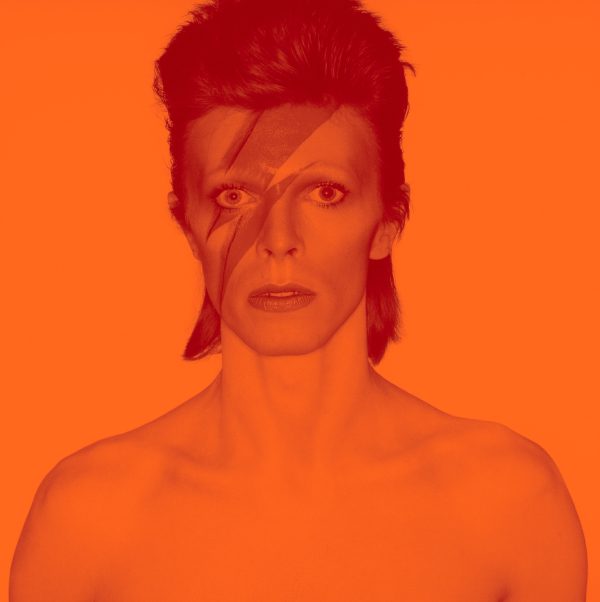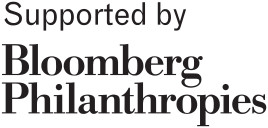
Photograph from the album cover shoot for Aladdin Sane, 1973. Photograph by Brian Duffy. Photo Duffy © Duffy Archive & The David Bowie Archive

Photograph from the album cover shoot for Aladdin Sane, 1973. Photograph by Brian Duffy. Photo Duffy © Duffy Archive & The David Bowie Archive

Quilted two-piece suit, 1972. Designed by Freddie Burretti for the Ziggy Stardust tour. Courtesy of The David Bowie Archive. Image © Victoria and Albert Museum
Bowie’s early costumes for Ziggy Stardust were inspired by Milena Canonero’s costumes for Stanley Kubrick’s film A Clockwork Orange, which he saw on its release in 1971. This take subverts the original pristine white jumpsuits worn by the “droogs,” the violent teenage hoodlums in the film. Bowie described this costume as “ultra-violence in Liberty fabrics”—a prominent fabric purveyor known for elaborate patterns.

Ice-blue suit, 1972. Designed by Freddie Burretti for the “Life on Mars?” video. Courtesy of The David Bowie Archive. Image © Victoria and Albert Museum
Though it looks more turquoise in person, this suit appears “ice blue” on film due to the particular film stock and processing used by director Mick Rock. The eye-popping colors of the ensemble were matched by Japanese eye shadows applied by makeup artist Pierre La Roche. “For weeks my stage persona went all geisha,” Bowie said. The colors stood out vividly in a white studio.

Promotional photograph of David Bowie for Diamond Dogs, 1974. Photograph by Terry O'Neill. Image © Victoria and Albert Museum
Terry O’Neill took a set of photographs as reference images for Guy Peellaert’s cover artwork for the Diamond Dogs album. A powerful image from the session was also used to promote the album. The central character of the book splayed at Bowie's feet, The Immortal (1958), is inspired by James Dean.

Stage set model for the Diamond Dogs tour 1974. Designed by Jules Fisher and Mark Ravitz. Courtesy of The David Bowie Archive. Image © Victoria and Albert Museum
Bowie’s Diamond Dogs tour took rock theater to a new height. Design inspirations included the Expressionist films The Cabinet of Dr. Caligari (Robert Wiene, 1920) and Metropolis (Fritz Lang, 1927), as well as George Grosz’s caricatures of a corrupt 1920s Berlin. The elaborate set, which evoked a decaying urban world, cost around $250,000 and took thirty-five people a day to construct at each venue.

Cut up lyrics for “Blackout” from Heroes, 1977. Courtesy of The David Bowie Archive. Image © Victoria and Albert Museum
Bowie developed his own form of the cut-up technique in the 1970s, describing it as “a tool of writing to promote a new perspective.” These lyrics are for the song “Blackout” from the album “Heroes.”

Original photography for the Earthling album cover, 1997. Photograph by Frank W. Ockenfels 3. © Frank W. Ockenfels 3
Bowie here faces away from the camera, in contrast to all his other album covers. However, his red, spiked Ziggyesque haircut is immediately recognizable. He wears the Union Jack coat he co-designed with Alexander McQueen. The photographer Frank Ockenfels, a technology enthusiast like Bowie, designed the image to be superimposed onto a vivid green English landscape.
David Bowie is
March 2–July 15, 2018
Organized with unprecedented access to David Bowie’s personal archive, this exhibition explores the creative process of an artist whose sustained reinventions, innovative collaborations, and bold characterizations revolutionized the way we see music, inspiring people to shape their own identities while challenging social traditions. David Bowie is has been touring globally for the past five years and is taking its final bow at the Brooklyn Museum, providing an opportunity to view this one-of-a-kind material.
David Bowie is presents approximately 400 objects drawn primarily from the David Bowie Archive, including the artist’s original costumes, handwritten lyric sheets from famous songs, original album art, photographs, and videos, all tracing Bowie’s creative process from his teenage years in England through his last twenty years, when he resided in New York City. The archive is presented within an immersive, multimedia installation that includes continuous audio along with projected animation and video.
Highlights of the exhibition include more than 60 custom-made performance costumes, including six designed by Freddie Burretti for Ziggy Stardust / 1980 Floor Show and seven designed by Kansai Yamamoto for Aladdin Sane. There are 85 handwritten lyric sheets, including those from “Fame” and “Fashion”; drawings, including a sketch for the Young Americans album cover; and oil paintings, including two of musician Iggy Pop, all by Bowie. There are also more than 40 pioneering music videos, television clips, and filmed roles as well as a multimedia presentation of international tour footage with rare scenes from the legendary Diamond Dogs tour, filmed in Philadelphia. A custom audio mix made up of snippets of Bowie’s songs—produced by longtime collaborator Tony Visconti—is also featured.
David Bowie is is organized by the Victoria and Albert Museum, London.

The Brooklyn Museum presentation is organized by Matthew Yokobosky, Director of Exhibition Design, Brooklyn Museum.
Sound experience by

Lead sponsorship for this exhibition is provided by

The exhibition is accompanied by a richly illustrated catalogue edited by Victoria and Albert Museum Theater and Performance curators Victoria Broackes and Geoffrey Marsh, with essays by Camille Paglia, Jon Savage, Howard Goodall, Christopher Breward, Oriole Cullen, Nicholas Coleridge, and a roundtable discussion with Sir Christopher Frayling, Philip Hoare, Mark Kermode, and Geoffrey Marsh.




